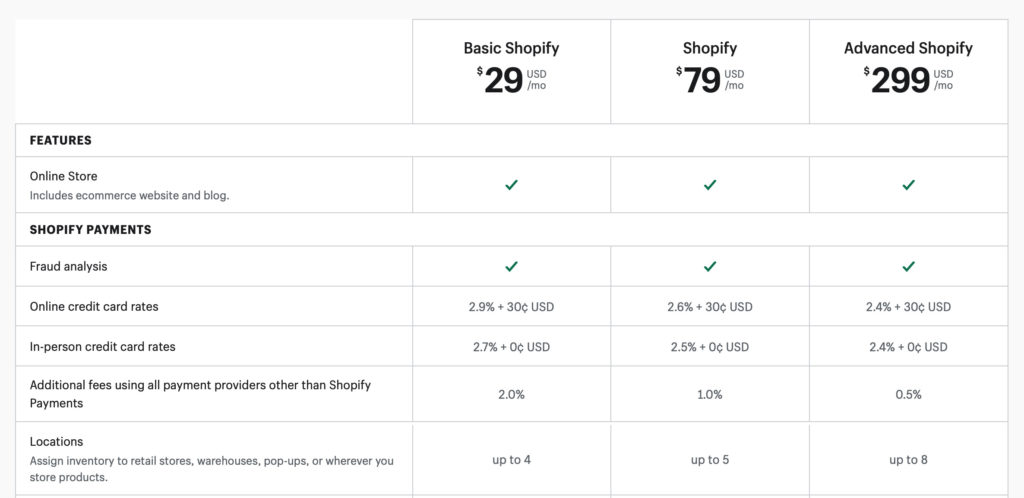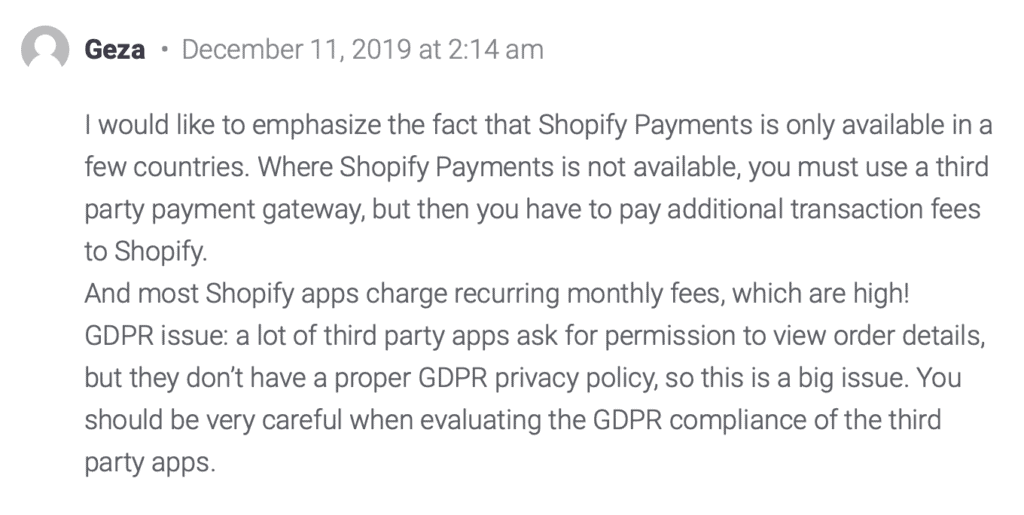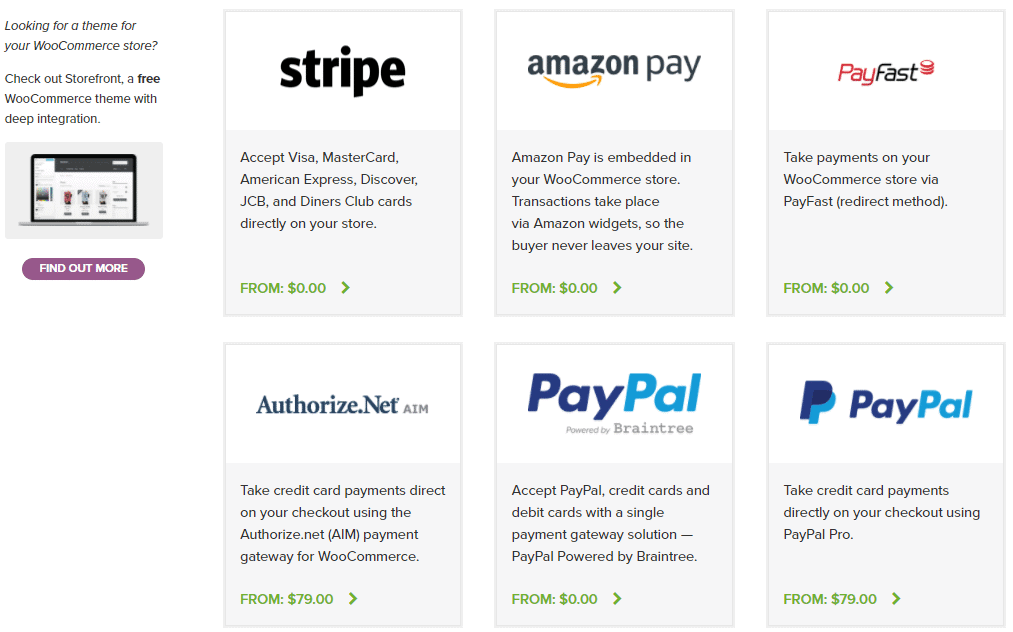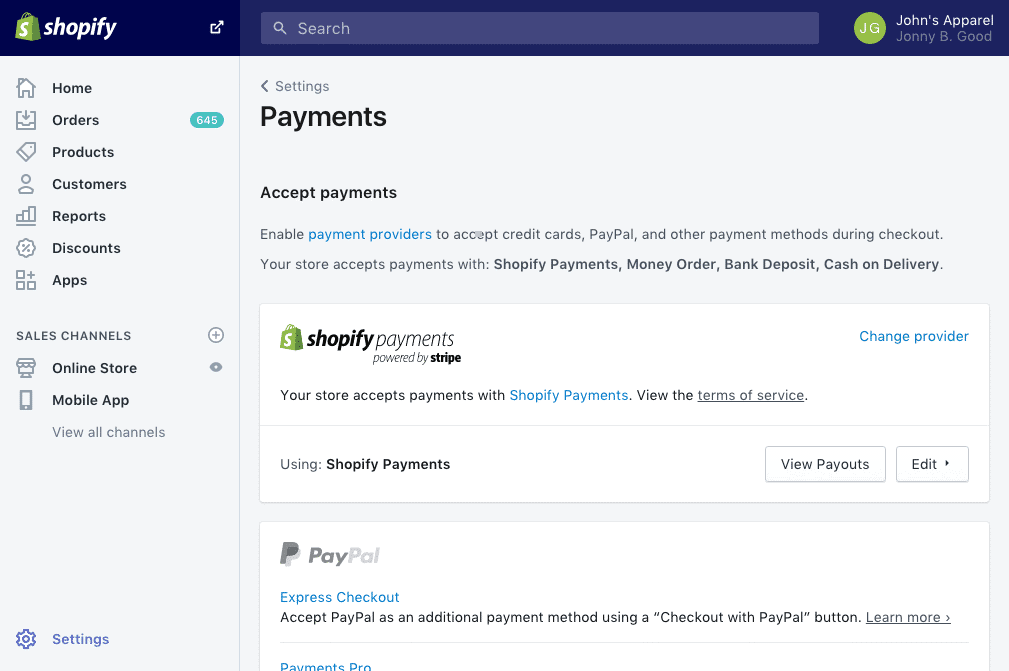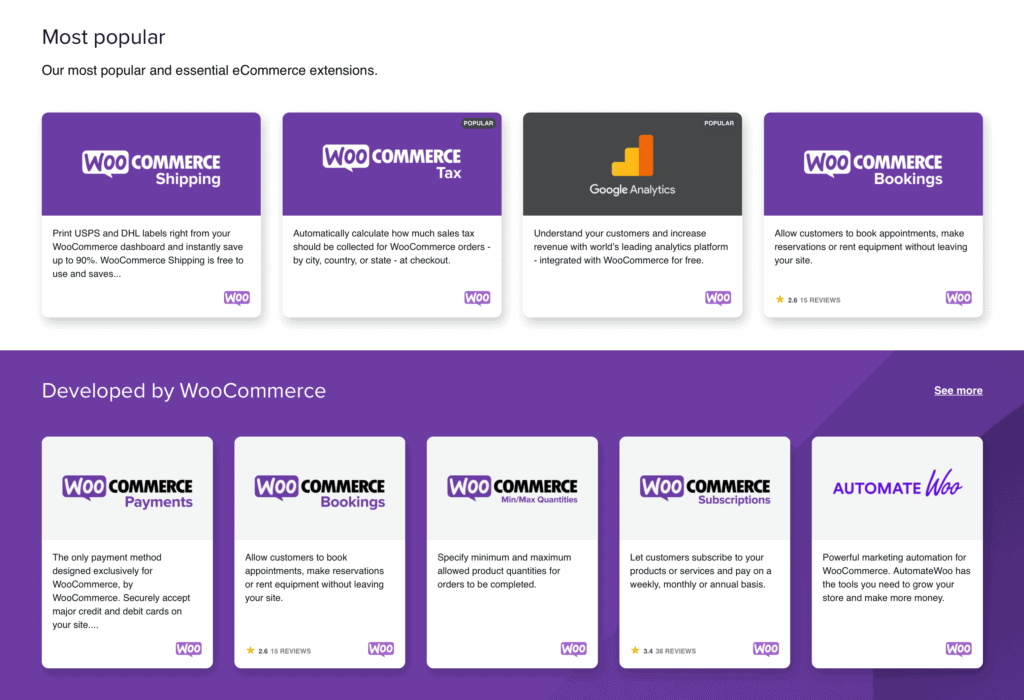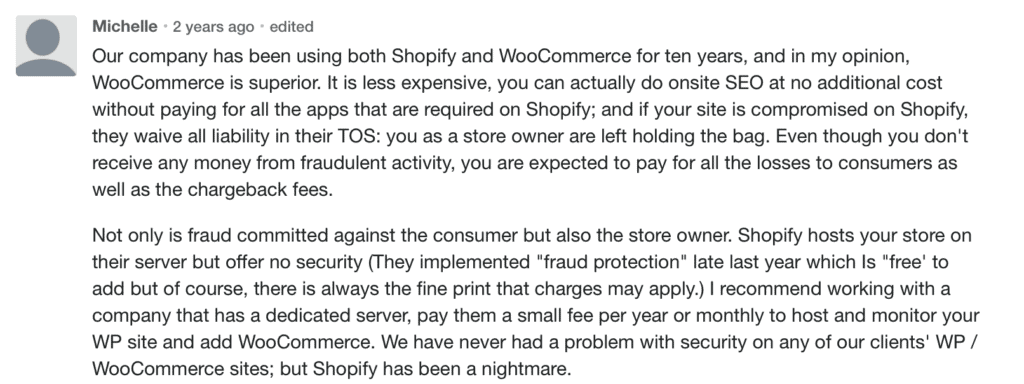Shopify vs. WooCommerce – Pros & Cons of Each
If you’re looking to build an eCommerce website, there’s a good chance you have your sights on building with either Shopify or WooCommerce (the eCommerce platform that works with WordPress). Which one should you use? In this article, we’ll unpack the pros and cons of each platform and the best-use cases for each, so that you can make an informed decision.
First, a quick back story. I don’t often drop everything I’m doing to write an article and do a full breakdown, but in this case that’s exactly what I decided to do. After talking to a number of different web agencies, a potential client of ours has narrowed down their top-choices to moving forward with us for a WooCommerce solution, or going with another company that is pitching a Shopify solution. During our follow-up call, he asked for my thoughts.
While I don’t think one platform is always better than the other, I think there are certain situations where one is better than the other. I gave him some initial thoughts on the call and told him I would do some more research and get back to him.
Since I really want what is best for our clients, I decided to do a deep-dive, so that I could advise from a fully-informed perspective. I interviewed colleagues who do both WooCommerce and Shopify sites, read numerous reviews and comparisons, and even read the comments in those posts about different users’ experiences. The result is this blog post. Enjoy!
If you’re looking for the summary, click here to skip the conclusions.
Cost to Operate
Shopify is a hosted platform, so each of their plans include a domain name, hosting for your website, a SSL certificate and unlimited file storage.
It is worth mentioning, however, that this pricing doesn’t include third-party tools and add-ons that you will need to build and customize your Shopify experience.
- Do you want to add video backgrounds to your store? $6.99/month.
- If you want to use the Facebook Messenger chat app using Recart, that will be $29/month.
- Do you want to offer up-sells? Bold Up-sell costs anywhere between $9.99/month and $89.99/month, depending on the features you need.
These additional monthly costs can add up quickly.
WooCommerce works with WordPress, but you will need to pay for your own hosting, as it’s self-hosted. We recommend companies like WP Engine or Kinsta for your WordPress hosting. The cost for hosting will set you back about $30/month. Usually you get the domain name and SSL certificate for free. Most WooCommerce tools are free or have a minimal price tag, so there are fewer surprises and monthly costs.
Shopify requires a number of third-party tools, each with their own cost, and tend to cost more than WooCommerce tools.
Transaction Fees
Shopify is the only platform to enforce its own transaction fee, unless you use their payment gateway, Shopify Payments. If you want to use a third-party gateway, it charges 2% (on top of your third-party payment gateway) unless you pay for one of their higher plans.
If you upgrade to their Advanced Shopping tier ($299/month) then the fee for using a third-party merchant account drops to 0.5%. Let’s say you want to use Stripe for your payment processor, you’ll pay Shopify’s 2% + Stripe’s payment processing fee. If you’re content with Shopify Payments you should be okay.
WooCommerce doesn’t charge any transaction fees, so you can use whatever payment gateways you want and negotiate rates with them. You will still pay the bank or payment gateway charges, like if you’re using PayPal or Stripe, but those are all the fees that you will incur.
Ease-of-Use / Speed-to-Launch
Both Shopify and WooCommerce are easy to use. However, for beginners/novices or DIY users, Shopify has the edge in ease-of-use and speed-to-launch. If you’re planning to use a developer or agency to build your website, then both will be equally easy to use once setup. If you’re looking to launch an eCommerce store very quickly, you’ll be able to launch it faster on Shopify.
Drop shipping/Fulfillment
When it comes to drop shipping and fulfillment, WooCommerce is easier and has more options than Shopify. Shopify has a number of options, but you must be on at least the Advanced Shopify plan. There are numerous options for drop-shipping and fulfillment with WooCommerce.
Add-ons
When it comes to add-ons, both Shopify and WordPress/WooCommerce have a lot of options.
- Shopify has around 1,200 apps
- WordPress has 50,000+ add-ons and plugins
For certain things you want to do on Shopify, you’ll only find one option. On WordPress/WooCommerce, you’ll typically find 5-10 options and you can pick the one that will work best for you. If what you want to do is not available on WooCommerce, it’s easy to write something custom or have a developer tweak something. App development for Shopify is expensive, so you’ll most likely be stuck with whatever is available.
Full Control
On Shopify you don’t have full control over everything, and you’re limited to set plans. Your data lives on the Shopify servers. Certain aspects you have very limited control over, for example: you can only moderately customize the checkout and thank you pages.
WooCommerce is open source and you have full control and ownership. There’s much more creative control on WooCommerce. You can fully customize the entire purchase experience.
Despite Shopify taking care of everything, their terms of service waive their liability if there are issues. See Michelle’s comment:
Tracking Conversion
On Shopify, you can embed tracking scripts for analytics and conversion tracking. However, because of the limitations of the checkout and thank you pages, it can be harder to track conversions with tracking scripts.
On WooCommerce, because you have full control over the experience as mentioned above, you can easily track conversions and detailed analytics on your users’ actions.
SEO
While both Shopify and WooCommerce have ways to customize your SEO to improve your search engine rankings, WooCommerce has more SEO tools and control. Yoast SEO is the most popular tool and gives you a lot of control. WordPress is optimized for SEO and enables you to get your site ranking high.
Shopify doesn’t give you complete control of page URLs and has some limitations when it comes to what you can customize for SEO. There are SEO apps available for Shopify, but none as well known as Yoast SEO.
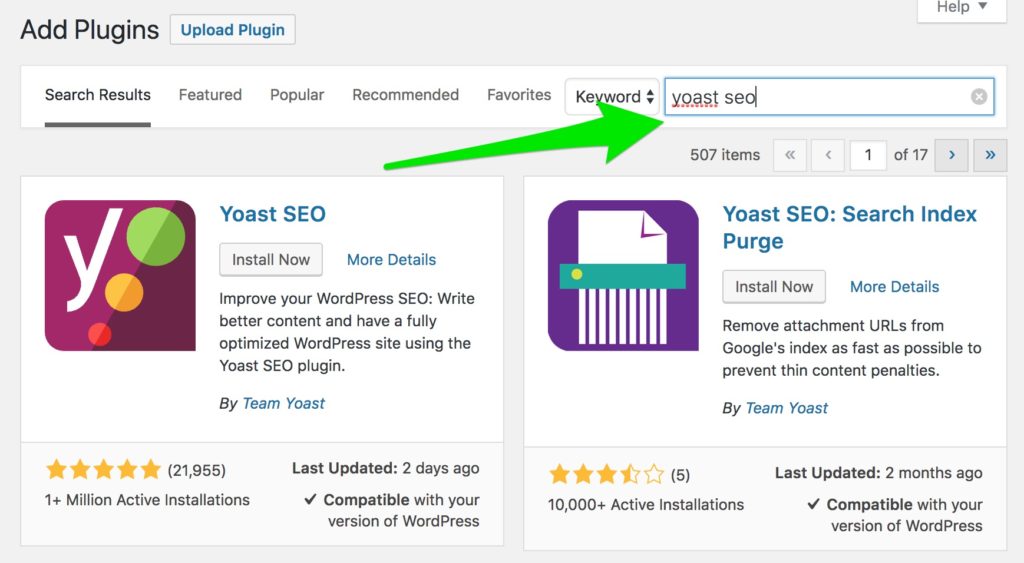
Yoast SEO is one of the most popular SEO tools for WordPress and it’s free.
Value for the Money
WooCommerce is open source and generally a better value for the money. There are tens of thousands of free tools and even the premium ones that you pay for are very low cost. The market is very competitive and that keeps prices even for premium tools very affordable.
Shopify does have a number of free apps, but often the apps you really want to use come with a monthly fee. Shopify is attractive because of their seemingly low cost, however once you really get into it, the price of the add-ons you need to achieve your goals really add up.
GoDaddy takes a similar approach to their services, offering a low price and then “nickel and diming” you for everything and locking you into their services; we’re not a fan.
E-commerce Market Share / Popularity
According to BuiltWith in April 2021, WordPress is used by 40% of all websites on the internet. WooCommerce is used by 30% of Top 1 Million sites. Shopify is used by 18% of Top 1 Million sites.
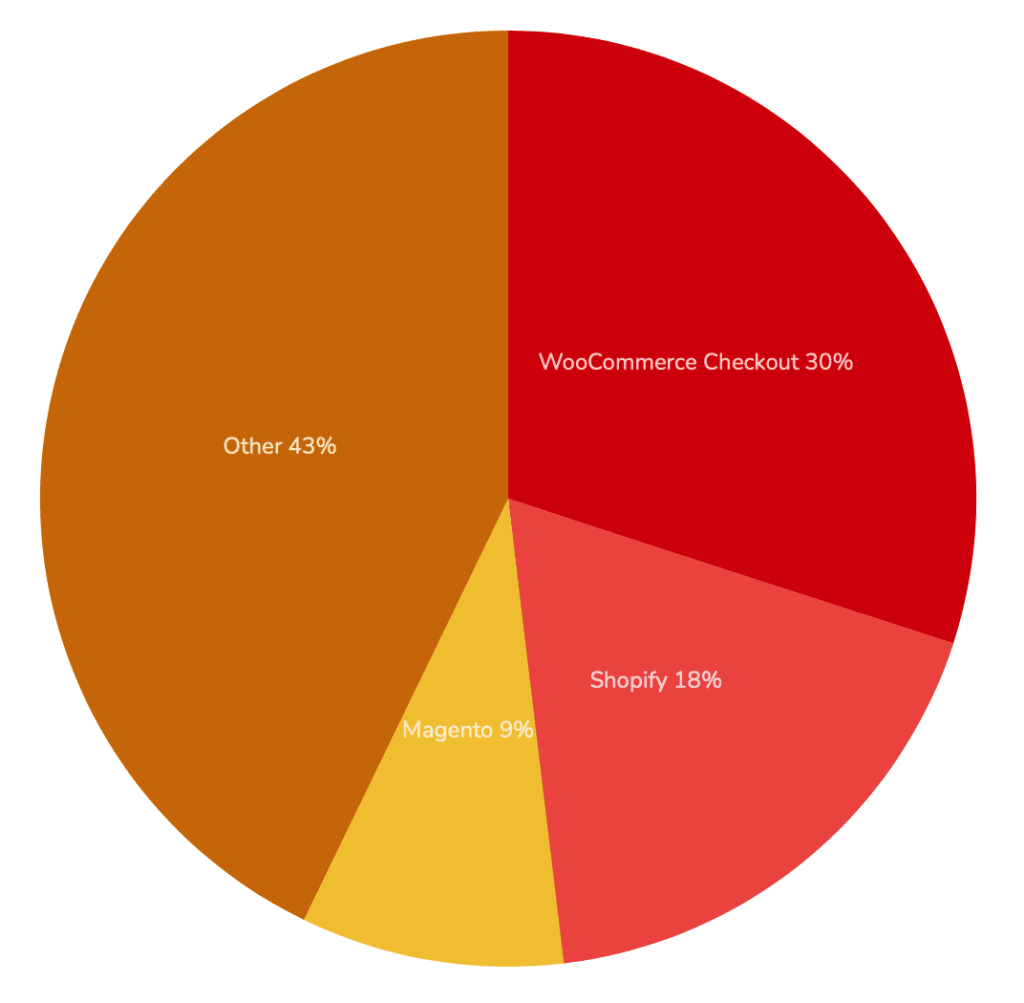
BuiltWith eCommerce Statistics of Top 1 Million sites as of April 2021.
WooCommerce and Shopify are both very popular and the two most popular eCommerce platforms.
Data
With WooCommerce, you own your data. It will be on the whatever web-host you select and is fully portable. Do you want to edit the database or arrange data in a certain way? No problem.
Shopify gives you access to all of your data, but it lives on their servers.
Support
Shopify has dedicated support via phone, email and live chat. However, depending on what plan you’re on and what kind of help you need, sometimes you’re unable to reach someone.
My friend Chris deals with a lot of Shopify clients. He says “I still find support to be pretty great, but as a Shopify Partner, I get faster support options. As a merchant, I suspect the queue for the support chat is probably pretty long nowadays.” This is confirmed by Jeff’s customer-experience trying to reach Shopify a few months ago:
If Shopify support is busy, not answering or has a long queue, you’re out of luck.
Since WooCommerce is self-hosted, you get to pick where it’s hosted. If you’re on a reputable web host like WP Engine or Kinsta, then you’ll have excellent support. On top of that, Wordpress is a huge community with extensive documentation and open source solutions to all kind of problems or issues.
There are also digital agencies that provide WordPress & WooCommerce support on Website Care Plans. Our clients rely on us to provide support for their WooCommerce sites.
Conclusions
Bottom line: WooCommerce and Shopify are both excellent eCommerce platforms. There are certain situations where each one outshines the other. The most important thing is that you’re working with a reputable partner that you can trust, who understands your goals and objectives and is committed to helping you reach them.
We’re all about delivering great design, support and experiences to help our clients get results. If you’d like a quote, please reach out. We’d love to talk with you.
Best Uses for WooCommerce
If you want flexibility and control, WooCommerce is better. Some products have been banned from Shopify, so you’re at the whims of their decision making. WooCommerce has a great ecosystem of plugins and support with WordPress. Your cost of ownership will be lower and there is a wide range of support options so you’ll always have reliable support.
If you want more control over your SEO rankings or plan to drop ship or want to be able to use your own payment gateways, then those are more great reasons to use WooCommerce. You’ll get a better value for your money and have more control over your costs.
Best Uses for Shopify
If you’re looking to do it yourself and want the simplest, most beginner-friendly way to launch an eCommerce store, Shopify is a good choice. As long as you are okay with using Shopify payments for your gateway, not selling complicated products with many variations (natively limited to 100 variations), and don’t need full control over the experience, Shopify will work well for you. If you’re doing it yourself, you can get your site up quicker on Shopify, so that’s a bonus.
To my potential client and to everyone reading, I hope this helps you make a more informed decision and we look forward to working with you. Have a thought on Shopify vs. WooCommerce? Post your comments below.
Share this post
We focus on beautiful web design that delivers results for your organization. Our specialty is creating customized WordPress websites.
Are you looking for more traffic, leads and customers? We provide on-going digital marketing to help you reach more customers and grow revenue.
About Us
Johnny Flash Productions
Johnny Flash Productions is a creative agency based outside of Washington D.C. that focuses on digital strategy, web design and development, graphic design and event production that helps businesses get better results from their marketing.
We had a great experience working with Joli and the team at Johnny Flash. Their whole process was very helpful to shaping and sharing our website message.

We found Johnny Flash Productions to be professional and a pleasure to work with. Their industry knowledge and creative approaches were incredibly helpful.
Our new website exceeds our expectations and we look forward to continuing our relationship with Johnny Flash Productions with their responsive and ongoing website upkeep, maintenance and SEO.

John and his team are great to work with. We have worked with them on a broad range of projects including logo development, campaign materials and website design. They are a great partner!

When we all get a little too busy, sometimes we forget to say a heartfelt "Thank You"! I am so grateful that God led us to partner with you. I know good things will come from our hard work done together in His name. The website is terrific. Pure and simple.
Thanks for your expertise, guidance and always friendly attitude.

John and his team at Johnny Flash Productions did an amazing job on our new company website! John was very patient and professional throughout the entire process and always responsive to any request we had.
I would definitely recommend their services to anyone looking to create a website!

I recommend Johnny Flash Productions because they respond promptly and with honesty when requesting their services, they are very professional and I am a satisfied client!
They fulfilled my expectations with the website and branding project. It has already been a success and helped us reach our goals for our business. Thanks Johnny Flash Productions.

It has been such a pleasure working with John and Nicole to develop our WordPress website. The team is very professional and worked closely with us during the entire process. We couldn't be happier with the result, we love our new website.
I definitely recommend Johnny Flash Productions!

Johnny Flash redesigned both our church website and our preschool website to align with our new branding, helped us switch web hosts and met some tight timelines as well. John and his team are always professional, have fresh ideas and are quick to respond to questions.
They also worked us to revamp both websites within our set budget while still providing a quality web design and custom look. If I could give them ten stars, I would!

Johnny Flash Productions gets results building stand-out websites that are optimized for success! Their team of professionals worked quickly to get to know my business and developed a plan of action. Their designers developed an amazing design that exceeded our expectations. If your organization or business is looking to build or improve your presence online.
I highly recommend Johnny Flash Productions!

I must admit that I was not crazy about revamping our website, primarily due to the time commitment and cost. However, in looking through the updated content this morning, the new website looks terrific and was well worth the time and expense.
Thanks to you and your team for all of your hard work.

Working with John and his team has been such a wonderful experience! They consistently go above and beyond to quickly complete our requests, and it's great working with a team of true experts.
I highly recommend them for anyone looking for WordPress developers.

John has been managing my website SEO and Google Ads for only a few months now and his services have already generated profitable leads. I can’t say enough about his company’s professionalism, promptness and results oriented approach. Hiring his company has been an excellent business decision!!

We used Johnny Flash Productions to help us recreate our website and to make it more visually appealing and more current. Working with them was very pleasant and easy. They really listened to what we were looking for and worked within that framework.
I would highly recommend them. I am happy to provide a reference or answer any questions that you may have.

I was looking for a web designer who was not only talented, but could deliver - and keep delivering what I needed month after month. The team at Johnny Flash Productions brought ideas to the table that complemented what I wanted to do with my website and their design exceeded my expectations.
I was willing to pay more for their continuing monthly service than I had paid previously because they laid out what I could expect from their team. So far, they have under promised and over delivered.

Johnny Flash Productions has played an integral role in the growth of our business. From logo redesigns, website design and management, fliers, banners, signs and more, they have done an incredible job of taking our ideas and WOWing us with his visual designs.
John's knowledge base allows them to understand our ideas and concepts and bring it all together in a professional, well thought out deliverable. Their work has always exceeded our expectations in both quality and speed.
We look forward to continuing our long business relationship as he continues to stay on top and ahead of visual marketing trends without losing it’s classic appeal.

Excellent WordPress Web Designer, we are so lucky to have them design our website we were very satisfied with the results!

I would like to thank Johnny Flash Productions for there great service my company has been able to get to get to the top of Google searches in half the time most companies take. I am now receiving 3 to 5 viable leads a day that all lead to service work for my company. And I can not thank them enough for all of there support with my site and maintaining it for me.

Johnny Flash Productions helped breathe new life into Immanuel’s online presence with their wonderful redesign of our website. Aside from their consummate professionalism, flexibility and keen attention to detail, they were an absolute pleasure to work with.
It had to be a daunting task to be presented with the enormous number of expectations , hopes and ideas generated from our church’s website committee throughout the course of the website re-design, but if anything, Johnny Flash's resulting work exceeded all expectations.
I’m sure I can speak for all of us on the committee when saying that we’d heartily recommend Johnny Flash to any church or organization in need of a skilled, knowledgeable, easy-to-work with design company.

John Falke and Johnny Flash were incredible to work with and produced a very professional and progressive website for Covenant Park Consulting and were completely responsive to our vision and goals.

Professional, knowledgeable, friendly! Everything you could ask for in a website development firm/SEO company. Johnny Flash Productions is the best website development firm and SEO firm in Northern Virginia!

Johnny Flash and team approached the project with as much passion as we had (we're a very passionate team) for the site and logo refresh. We worked through the logo and website designs and within a couple of weeks, it felt as if we were all one company.
The team was super responsive, understood our vision for the logo/website and communicated clearly every step of the way.

The Johnny Flash team is incredibly skilled, attentive and patient. We are very happy with our new WordPress website!

I cannot begin to speak highly enough of Johnny Flash Productions. I was first alerted to their company by doing a Google search & found only one company around with so many 5-star reviews, so was curious if they could all be real. I found through working with John & Eowyn & the Johnny Flash team that we were able to collaborate to create the perfect website for our organization.

Efficient, effective and professional - Johnny Flash Productions did an awesome job of rebranding and migrating our WordPress website. We launched last week and there is positive feedback all around for the sleek, new, mobile friendly look.

Such an amazing service. A beautiful website that has already gotten the practice new business. John kept us on track so that our website was up and running in the time allotted. Thanks so much. Highly recommend.

Was a pleasure to work with Johnny Flash Productions to walk through the full life cycle of a complete redesign of several of our ministries websites. Working with people who are experts caused us to think outside the box in how we really tell our story through our website.
The entire team was great to work with and the value has been incredible! God is good!

John, Joli and Team provided the path forward for us on how to take our desire to have a brand new website to getting it launched and live. We started at a high level of who we were and what we wanted to accomplish with our website.
John provided an up front schedule of what tasks would be completed by when from their team.
There were tweaks along the way that we would make and feedback given, and it was always well received with the changes being made in a timely manner. Thanks John and Joli.

This process was so much easier than I expected. John listened carefully to what I was expecting to accomplish with our website and kept me focused on our objectives.
We are now able to register preschool students online (especially important during COVID). Parents are very happy that now they have the option to pay by credit card. I would highly recommend this company!

We regularly get rave reviews about our website. Often other non-profits have asked us for a referral. Johnny Flash was easy to work with and has always been responsive to our needs. They provided several built in tools that help keep our website from becoming stale.

We chose Johnny Flash Productions because I knew the person, John Falke. Relationships are important. Knowing character is important and relevant to business decisions. Knowing whether a person/business will stick by their word is important along with can they perform.
A company that can perform is good, but if they do not stick by their word, skill means nothing. You produced a great product, worked with us, gave a fair price and kept us on task.

John and his team do top quality design work, website work, and just about anything you would need to have a dynamic presentation in both print and digital media. Incredibly talented and innovative, you can call him with a "thought" that comes back to you better than you ever imagined. Truly professional and talented, I could not recommend more highly.

Exceeded all expectations in their abilities to professionally evaluate and customize our company WordPress website. Above all else, their customer service is the best I've dealt with in a long time with any company I've worked with in the past. I definitely recommend Johnny Flash Productions to anyone looking for exceptional service, professional detail and customer support.

Johnny Flash Productions was a joy to work with! They helped our church completely re-do our website. They also helped us refresh our look and logo. We have had many people comment on how much they love our new website and how much easier it is to navigate.

Johnny Flash Productions and their team were aces to work with. Their process was simple, and project schedule was on target.
More importantly, their Storybrand mindset opened us up to a whole new world for our website presence, business development and even our own client communication.

We have been very pleased with our website design experience with Johnny Flash. We appreciated how their structured process enabled our website team to prioritize our goals for the project and develop a final product customized to meet our individual needs.

Johnny Flash did a great job on our new Wellesley Hills Congregational Church website. Delivered on time and on budget. They helped us shape good content as well.
We were so satisfied we had them redo our Wellesley Nursery School in the Hills website also.

We have a fabulous website thanks to their excellent process.

I have worked with Johnny Flash Productions on 3 of my own websites and recommended Johnny Flash productions to two other family members who were also in need of new websites. We have all had an exceptional experience during the process.
The staff are very responsive, organized, on time and they follow through until the work is complete. We valued them so much that we use them for our monthly maintenance and they help with our advertising online.

We are truly grateful for our time working with John and his team. They were able to manage a full redesign within a relatively tight timeline and delivered an impressive site that also worked well through mobile devices as well.
They kept us on schedule as well and were a pleasure to work with. The team continues to be incredibly responsive following the initial launch.

They did excellent design work, were professional and responsive. They were an absolute pleasure to work with, and I plan on using them for future projects.

Johnny Flash Productions is a company that truly cares about their clients, this is obvious by not only their work ethic but they also the way they put their heart into every project they complete.
Johnny Flash Productions was a pleasure to work with, we look forward to working with them again in the future.

Our organization couldn't be happier with the beautiful website Johnny Flash Productions created for us. They helped streamline thousands of components from our previous site into a site that portrays the mission of our organization and tells the story of our purpose while bringing in and engaging new and returning visitors.
We wouldn't hesitate to use them again and have already recommended them to several people who have seen the quality of our new site.
We have also seen a remarkable uptick in response in those who have gone to the site just in the first few weeks since launch in signing up for future communications. That is the sort of prolonged engagement we have been looking for, and Johnny Flash Productions delivered beyond our hopes.



